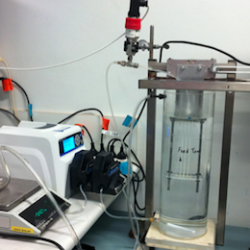A vibrating submerged hollow fibre module for fouling limitation in MBRs
Increasing shear rate at the membrane surface by cross flow velocity and air bubbling has been reported to decrease the fouling layer. However, the air scouring technique suffers from some limitations such as the difficulties to achieve an effective bubble distribution and the bubbling intensity limit beyond which no further improvement can be achieved with increasing the bubbles flow. Furthermore, the application of air scouring in the anaerobic membrane bioreactors might be limited due to the limited available biogas.
Shear rate can also be increased by using non-conventional methods such as vibration, which involves vibration or rotation of the membrane. These systems are known as the vibratory shear enhanced processes (VSEP) or vibrating membrane filter (VMF) and are generally based on flat sheet membranes. To date there are only few studies that have been conducted to investigate the effect of vibration on fouling limitation in submerged hollow fibre membranes. It was found that with the membrane vibration, the system is able to operate at a very low cross-flow velocity and with a very low TMP rising speed. However, more studies are still required to approve the viability of vibration techniques on fouling reduction. Vertical direction of vibration is normally used in the literature and no transverse direction of vibration has been reported. Transverse vibration might potentially require less energy consumption compared to the vertical vibration since no lift of the membrane module is necessary. Both model solutions (such as yeast, bentonite and alginate solution) and anaerobic bioreactor supernatant were used as feed solution in the study.
The results showed that the cake formation on the membrane surface was dramatically reduced with low frequency (3-25 Hz) and displacement (1 to 5mm). The rough estimation of the energy requirements to generate the transverse vibration was obtained based on the force acting on the fiber during transverse vibratory motion. Estimates indicate the potential for lowering energy inputs for fouling mitigations in submerged systems using transverse vibrating systems when compared with the traditional air sparging.
Research Team: Vicki Chen
Pierre Le-Clech
Yun Ye
Anusha Kola (PhD student)
Collaborators: Richard Stuetz (UNSW Water Research Centre)
Funding Body: ARC Discovery
Publications:
- Kola A; Ye Y; Le-Clech P; Chen V, 2014, 'Transverse vibration as novel membrane fouling mitigation strategy in anaerobic membrane bioreactor applications', Journal of Membrane Science, vol. 455, pp. 320 - 329, http://dx.doi.org/10.1016/j.memsci.2013.12.078
- Kola A; Ye Y; Le-Clech P; Chen V, 2014, 'Transverse vibration as novel membrane fouling mitigation strategy in anaerobic membrane bioreactor applications', Journal of Membrane Science, vol. 455, pp. 320 - 329, http://dx.doi.org/10.1016/j.memsci.2013.12.078
- Chen V; Kola A; Yun Y, 2013, 'Fouling in membrane bioreactors', in Hoek EMV; Tarabara VV; Volodymyr V (ed.), Encyclopedia of Membrane Science and Technology, Wiley-Blackwell,http://dx.doi.org/10.1002/9781118522318.emst032
